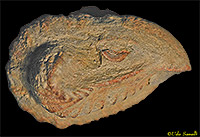Phylum Onychophora — Velvet Worms
Characteristics
- Caterpillar-like, 5 mm - 15 cm long
- Numerous paired, unjointed lobopods (legs)
- Head appendages: antennae, jaws, oral papillae
- Thin, chitinous cuticle is molted
- Covered in fine tubercles (sensory papillae), giving velvet-like appearance
- Produce sticky slime to capture prey
- Terrestrial in moist tropical forests
|

Closeup of head of a preserved velvet worm, Peripatoides sp.
See also labeled photo.
|

Velvet Worm, Peripatoides sp., preserved specimen
|

Possible stem-onychophorans (lobopods) from the Cambrian Period (labeled in larger image; not to scale)
|
|
Phylum Tardigrada — Water Bears
Characteristics
- Small (< 0.5mm), stubby-bodied
- 8 short, clawed legs
- Have a slow, lumbering gait
- Chitinous cuticle that is molted
- Oral stylets for piercing plants
- Most in moist film on lichens, mosses, and other small plants
- Capable of cryptobiosis: suspended animation to withstand drying
- Video of a marine heterotardigrade
|

Water Bear, probably Hypsibius sp. (Class Eutardigrada)
|

Water Bear, probably Hypsibius sp.
|

Marine tardigrade (Class Heterotardigrada)
|
|
Phylum/Class Dinocaridida† — Dinocarids
Characteristics
- Extinct; Primarily from Cambrian Period but one species survived into Devonian Period
- Segmented with broad lateral lobes
- Well-developed eyes (either 2 or 5)
- Ventral mouth
- Segmented feeding appendage(s)
- Anomalocarids included the largest predators of their time
- Sometimes considered a Class within Phylum Arthropoda
|

Radiodontids exhibit a diversity of feeding styles and persisted into the Devonian Period. Large image identifies genera, along with diet and geological period.
|

Two unusual basal Dinocaridids from the Cambrian Period: Opabinia (top) and Kerygmachela (bottom)
|

Fossil replica of Opabinia, from Burgess Shale, Cambrian Period
|
|
Phylum Arthropoda — Class Trilobita
Characteristics
- Extinct, but diverse fossil forms from 540-252 Ma
- Body divided into median and 2 lateral lobes by 2 longitudinal furrows
- Anterior cephalon (and in most, posterior pydigium) covered by platelike shields
- Segmentation visible in middle section (thorax)
- Appendages biramous (branched)
- Photos at right are organized by geological time period and Orders
See additional trilobite fossils here
|
Cambrian Period:
|

Life model of the Cambrian trilobite Olenoides sp. (Order Corynexochida)
See also labeled photo.
|

Naraoia spinosa head shield (Order Nektaspida; a stem-trilobite); Cambrian Period, China
|

Trilobite fossil, Elrathia kingi (Order Ptychopariida); Cambrian Period, UT
|

Trilobite fossil, Cambropallas telesto (Order Redlichiida); Cambrian Period, Morocco
|

Cephalon (head shield) of Oryctocephalus indicus (Order Corynexochida); Cambrian Period, Nevada
|

Agnostid Trilobite fossil, Ptychagnostus sp. (Order Agnostida); Cambrian Period, UT
|
Ordovician Period:
|

Trilobite fossil, Declivolithus titan (Order Asaphida); Ordovician Period, Morocco
|

Trilobite fossil, Flexicalymene retrorsa (Order Phacopida); Ordovician Period, Ohio
|

At least four Ampyx priscus trilobites in a migratory chain (Order Trinucleida); Ordovician Period, Morocco
|
Devonian Period:
|

Trilobite fossil, Chotecops ferdinandi (Order Phacopida); Devonian Period, Germany
|

Trilobite fossil, Akantharges mbareki (Order Lichida); Devonian Period, Morocco
|

Trilobite fossil, Cyphaspis sp. (Order Proetida); Devonian Period, Morocco
|

Trilobite fossil, Harpes perradiatus (Order Harpetida); Devonian Period, Morocco
|

Trilobite fossil, Dicranurus monstrosus (Order Odontopleurida); Devonian Period, Morocco
|

Trilobite fossil, Paralejurus sp.? (Order Corynexochida); Devonian Period
|
Carboniferous Period:
|

Enrolled trilobite fossil, Kaskia sp., in right lateral view (Order Proetida); Carboniferous Period, AL
|

Enrolled trilobite fossil, Ditomopyge parvulus (Order Proetida); Carboniferous Period, OK
|
|
|
|

























